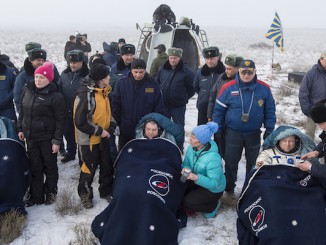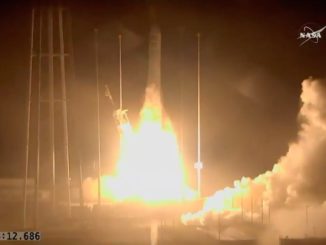
Flying by hand, Russian cosmonaut Alexander Skvortsov undocked his Soyuz space capsule from the International Space Station late Sunday (U.S. time) and maneuvered the ship to a new parking spot on the million-pound research complex, clearing the way for the arrival of a new Soyuz spacecraft Monday night after aborting its first approach.
Strapped into the center seat of the Soyuz MS-13 spacecraft, Skvortsov fired jets to back away from the aft port of the space station’s Zvezda module at 11:35 p.m. EDT Sunday (0335 GMT Monday). Crewmates Luca Parmitano and Andrew Morgan — from the European Space Agency and NASA, respectively –flanked the Russian cosmonaut commander on the left and right.
After retreating to a distance of about 100 feet (30 meters), Skvortsov commanded a roll maneuver to turn the Soyuz solar arrays, then flew his spacecraft around the space station to approach from above, targeting a link-up with a port on the Poisk docking compartment.
The Soyuz MS-13 spacecraft docked with Poisk at 11:59 p.m. EDT (0359 GMT) to complete the 25-minute relocation maneuver, the first such in-orbit swap of Soyuz parking spots since 2015.
The automated docking system on the Poisk module is no longer working, according to Russian engineers. The unpiloted Soyuz MS-14 spacecraft tried to dock with the Poisk module early Saturday, but had to abort the rendezvous after it was unable to lock onto its target from a distance of roughly 300 feet (90 meters).
Russian Soyuz and Progress space vehicles use Kurs radar systems to feed range, closure rate and other data into on-board computers, which control automated dockings with the space station. The active component of the Kurs rendezvous system flies on the Soyuz and Progress spacecraft, but a suite of passive navigation aids are installed on the station’s Russian docking ports.
Flight controllers in Korolev, near Moscow, believe the most likely cause of Saturday’s aborted docking attempt was a faulty amplifier on the passive Kurs system on the Poisk module.
The Soyuz MS-14 spacecraft has no crew on-board, and does not carry equipment to allow cosmonauts inside the space station to take remote control of the vehicle. That leaves an automated docking as the only way the Soyuz can link up with the station.
Skvortsov’s manual docking with the Poisk module clears the aft port of Zvezda — with a fully functioning passive Kurs system — for the Soyuz MS-14 spacecraft to attempt another automated approach.
Docking of the Soyuz MS-14 ferry ship is scheduled for 11:12 p.m. EDT Monday (0312 GMT Tuesday).
The Soyuz MS-14 spacecraft launched Aug. 21 (U.S. time) from the Baikonur Cosmodorome in Kazakhstan on a rare uncrewed test flight of a Soyuz vehicle. Russia’s space agency, Roscosmos, approved the test flight to validate the compatibility of the Soyuz capsule with the new-generation Soyuz-2.1a booster, which will replace Russia’s Soyuz-FG rocket for crew launches beginning next March.
The launch phase of the mission went off without a hitch.
Other objectives of the Soyuz MS-14 test flight include checkouts of a new motion control system and upgraded re-entry systems, which could be used on on a future unpiloted Soyuz payload return vehicle.
The Soyuz MS-14 spacecraft is set to deliver around 1,450 pounds (658 kilograms) of cargo and supplies to the space station, according to NASA.
The Russian Skybot F-850 robot, a two-legged, two-armed humanoid stand-in for a cosmonaut commander, is strapped into the Soyuz MS-14 spacecraft’s center seat.
The Skybot F-850 is not designed to manipulate any flight controls during the Soyuz mission, but sensors on the robot’s body are measuring key parameters — such as acceleration, vibrations, temperature and humidity — during the flight, including launch, docking and landing.
Once the Soyuz docks at the station, Skvortsov plans to conduct experiments with the robot for several days. The robot is designed to follow commands and replicate the movements of its human operator.
Before Saturday’s aborted docking, the Soyuz MS-14 spacecraft was scheduled to depart the station and return to Earth with the Skybot F850 robot Sept. 6. Russian officials have not confirmed if the Soyuz spaceship’s return would remain on schedule after the delayed docking.
Email the author.
Follow Stephen Clark on Twitter: @StephenClark1.



